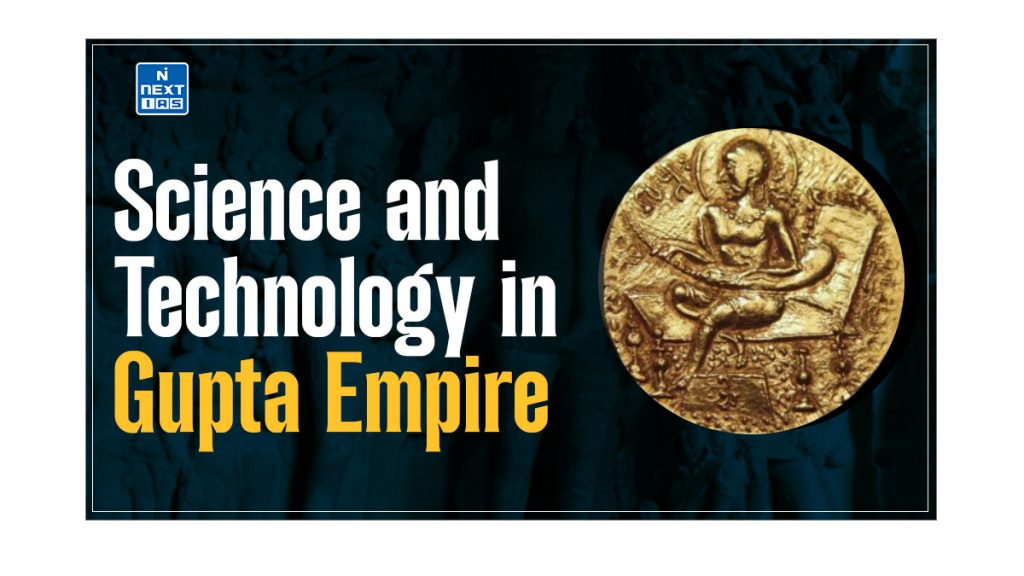
The Gupta Empire, often called the “Golden Age” of ancient India, was a period marked by profound advancements in science and technology. This era witnessed pioneering achievements in fields like mathematics, astronomy, metallurgy, and medicine, laying foundational principles that would influence both Indian and global knowledge systems for centuries. This article aims to study in detail the key contributions of Gupta science and technology, exploring their impact on subsequent civilisations and their enduring legacy in various domains.
About Gupta Empire
- The Gupta Empire was an ancient Indian empire founded by Sri Gupta. It stretched across northern, central, and southern India between 320 and 550 CE.
- The period is called the Golden Age of India due to its achievements in arts, architecture, sciences, religion, and philosophy.
- During this era, India witnessed a renaissance in cultural and intellectual pursuits, with significant contributions from figures like Kalidasa in literature and Aryabhata in science.
- The Gupta rulers fostered an environment of stability and prosperity, facilitating advancements in various fields and leaving a lasting legacy on Indian civilisation.
Read our detailed article on the Gupta Empire, Gupta Economy, Gupta Society, Gupta Administration, Gupta Literature, Gupta Art and Architecture, Guild System and Gupta Inscriptions.
Science and Technology in Gupta Empire
- The Gupta Empire (320-550 CE) is often regarded as the Golden Age of India. It was marked by remarkable achievements in various fields, including science and technology.
- During this era, India became a centre of intellectual and scientific advancements, profoundly impacting future generations.
- The period witnessed groundbreaking progress in areas like mathematics, astronomy, medicine, and metallurgy, all of which were fostered under the patronage of the Gupta rulers.
- Prominent figures such as Aryabhata, a pioneer in mathematics and astronomy, and Varahamihira, an influential astronomer and astrologer, made significant contributions.
- Their works not only enriched Indian knowledge systems but also influenced scientific thought globally, cementing the Gupta Empire’s legacy as a period of extraordinary intellectual flourishing.
- The Gupta age is known for significant developments in astronomy, astrology, mathematics and metallurgy.
These significant fields have been discussed in detail in the following section.
Astronomy in Gupta Empire
- In the field of astronomy, Varahamihira, a distinguished scholar and one of the nine jewels in the court of Chandragupta II, made significant contributions.
- He compiled the Romaka Sidhanta, a seminal work reflecting the influence of Greek astronomical ideas.
- Additionally, Varahamihira authored the Panchasiddhantaka, a collection of five treatises that further advanced the understanding of celestial phenomena.
- His works not only enriched Indian astronomy but also demonstrated the integration of diverse astronomical traditions.
Mathematics in Gupta Empire
- The Gupta period in ancient India witnessed remarkable advancements in mathematics, laying foundational principles that continue to influence modern mathematics.
- Among the key figures of this golden age was Aryabhata, whose pioneering work in mathematics and astronomy set new standards.
- The great mathematician Aryabhatta, was the legendary mathematician of the Gupta Era.
- The introduction of the zero concept, alongside the decimal system development, marked significant milestones.
- Additionally, advancements in algebra and geometry during this period demonstrated the sophisticated mathematical understanding of ancient Indian scholars.
- The achievements of Aryabhatta in the field of mathematics are:
- Aryabhatitiya,
- Arya Siddhanta,
- Calculated the value of Pi,
- Calculated the length of the solar year,
- Solved problems in Trigonometry, and
- Developed Chakra Yantra, Gola Yantra and shadow devices.
Metallurgy in Gupta Empire
- The Gupta period is renowned for its advancements in metallurgy, particularly in iron and copper.
- Gupta craftsmen made significant strides in metalworking, producing intricate and durable artefacts.
- One of the most notable achievements of this era is the Iron Pillar of Delhi, which was manufactured in the fourth century A.D.
- This impressive structure has remarkably resisted corrosion for over 15 centuries, showcasing the advanced iron technology of the time.
- Additionally, the period saw sophisticated techniques for minting coins and creating metallic art objects.
- These achievements highlight the exceptional skill and innovation of Gupta metallurgists, which contribute to the functional and artistic aspects of their craftsmanship.
Medicine (Ayurveda) in Gupta Empire
- The Gupta period saw significant advancements in Ayurvedic medicine, particularly through key texts like the Sushruta Samhita and Charaka Samhita. These texts laid the foundation for many practices in ancient Indian medicine and surgery.
- The Sushruta Samhita is renowned for its detailed descriptions of surgical techniques, including various surgeries, surgical instruments, and procedures. It reflects a high level of sophistication in medical practices during the Gupta era.
- Herbal remedies and treatments were extensively documented and refined, contributing to a rich pharmacopoeia that addressed many ailments.
- The Gupta period also emphasised preventive healthcare practices, including early forms of vaccinations and health maintenance strategies that aimed to prevent diseases rather than merely treating them.
Engineering and Architecture in Gupta Empire
- The Gupta period marked significant advancements in civil engineering. Builders employ innovative techniques and materials to enhance structures’ durability and aesthetic quality.
- This era saw the development of sophisticated construction methods that allowed for the creation of impressive architectural marvels.
- Advanced tools and architectural designs facilitated the construction of monumental structures such as temples and forts.
- The Gupta architects employed precise engineering techniques to create intricate carvings, expansive temples, and robust fortifications.
- Gupta engineers contributed notably to irrigation, developing advanced systems to support agriculture and improve water management.
- These systems reflected an understanding of hydraulic engineering and played a crucial role in enhancing agricultural productivity and sustainability.
Conclusion
The Gupta Empire’s scientific and technological achievements represent a remarkable chapter in India’s intellectual history. The innovations in mathematics, astronomy, metallurgy, and medicine during this period not only advanced knowledge but also established standards that influenced subsequent civilisations. The enduring legacy of Gupta science and technology underscores the Empire’s critical role in shaping the trajectory of global intellectual development, leaving a lasting imprint on historical and contemporary fields of study.
Frequently Asked Questions (FAQs)
What did the Gupta contribute to science?
The Gupta Empire significantly contributed to science, particularly mathematics and astronomy. Aryabhata introduced the concept of zero and the decimal system and accurately calculated the value of pi. The Gupta period also saw advancements in medicine, with detailed knowledge of surgery and medicinal plants, and in astronomy, with theories on planetary motion and eclipses.
What were the achievements of the Gupta Empire in technology?
The Gupta Empire made notable advancements in technology, particularly in iron metallurgy, with the construction of the famous Iron Pillar of Delhi, which resists rusting. They also developed techniques in coin minting and textile production, enhancing the quality of materials like silk and cotton. Additionally, advancements in water management systems and architecture led to more efficient irrigation and the construction of grand temples and structures.





